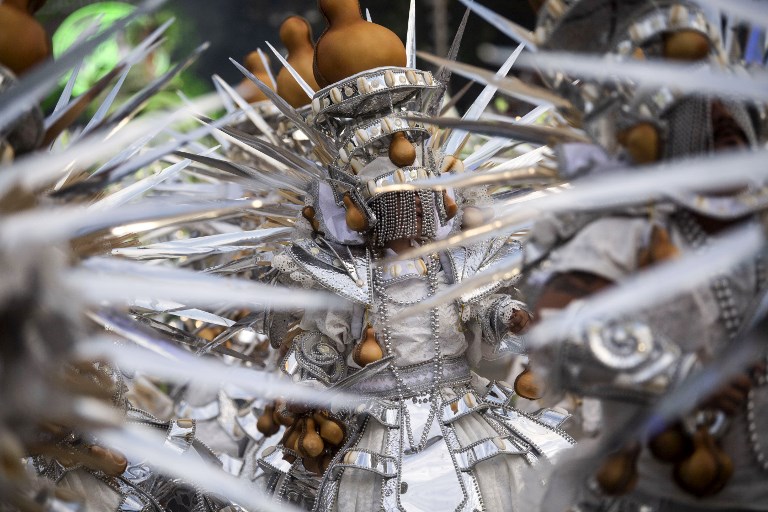Rio Carnival revels in last night of partying and political protest

Members of Mocidade Independente de Padre Miguel samba school perform during the second night of Rio’s Carnival parade at the Sambadrome in Rio de Janeiro, Brazil on March 5, 2019. AFP
RIO DE JANEIRO, Brazil – Rio threw the second and final night of its celebrated carnival right through to dawn Tuesday in a show that blended political protest with a return to Brazil’s roots.
More than 70,000 people sang at the top of their voices Monday night as the seven final samba schools paraded through the city’s Sambadrome, the huge concrete arena built by Brazilian architect Oscar Niemayer.
The night before, another seven of the city’s competing samba schools — a mixture of trained dancers and enthusiastic neighborhood locals — had staged their own colorful parade, in costumes and with giant decorated floats.
The first school of 2,500 dancers and musicians made their way past the crowds and the judges at a reasonable hour of Monday evening, and the last did so at the crack of dawn Tuesday.
As they do every year, Brazilians briefly forget their woes during the world’s biggest party, including the economic crisis, bitter political divisions, massive corruption scandals and a sky-high murder rate.
Article continues after this advertisementThe fiesta serves as a cathartic coming together for the city, reflecting the joy, suffering and dreams of its denizens.
Article continues after this advertisement“It’s another way of crying. And protesting: we are alive!” said an editorial in the daily O Globo on Monday.
The crowd this year included celebrities, such as football great Neymar, who was seen at the stadium with funk singer Anita. Neymar plays for France’s Paris Saint-Germain and is in Brazil for treatment of a foot injury.
The city had been battered by torrential summer rains in the hours leading up to the start of the parade on Sunday, but the skies cleared, as if by magic, just as the first samba school sashayed into the spotlight.
And the magic of the parade has not dried up either in the first carnival to be staged under the new far-right president, Jair Bolsonaro. Sunday saw a display of spectacular floats featuring giant flamboyant birds, slave ships, the Roman colosseum and of course scantily clad dancers in exotic headdresses throbbing to the deafening beat of drum bands.
Criticism and satire
But once again the carnival served as canvas for political messages, sending up the “circus” of the political capital Brasilia or condemning widespread corruption and a growing intolerance towards the black and LGBT communities.
Those messages appeared to be directed pointedly at Bolsonaro, notorious before the election for race-baiting, sexist and homophobic comments.
The parade Monday night continued that satirical theme.
The Mangueira school caused a stir with a theme of popular heroes from Brazilian history who do not feature in school textbooks, mostly from the traditionally neglected black and indigenous communities.
The highlight of that parade was a homage to Marielle Franco, a black city councilor and human rights activist from one of the city’s poor favela neighborhoods who was shot dead last year.
Another highly anticipated display was from the Portela school, which holds a record 22 carnival wins and partnered French fashion guru Jean-Paul Gaultier to design its dancers’ costumes.
It highlighted Brazil’s roots by celebrating the memory of Clara Nunes, an icon of the 1970s samba scene and the first artist to defend the rights of African-Brazilian religions.
Budget cuts
The show also celebrated the resilience of the sambas schools themselves, whose subsidies from the city have been reduced since Marcelo Crivella, a former Evangelical pastor, became mayor in 2017.
The carnival has also tamped down its traditional feel of debauchery, which normally draws around 1.5 million visitors to the “Marvelous City,” including foreign tourists with their much-needed cash.
But for Jairo Machado, a dancer with the Beija-Flor samba school, it would take more than budget cuts or torrential rain to dampen the legendary party-goers’ enthusiasm.
“Despite the weak investment by the city, the schools have overcome all that, they have managed to throw a good carnival,” he told AFP.
The judges are to announce the winner of the samba contest on Wednesday based on three criteria: the inventiveness of the floats, the theme of parade, and the quality of the dancing in the sambadrome.
For the schools, that means months of work to makes the costumes, build the floats, rehearse their dance steps and learn their songs, making winning a huge prize for a school and its local community. /cbb